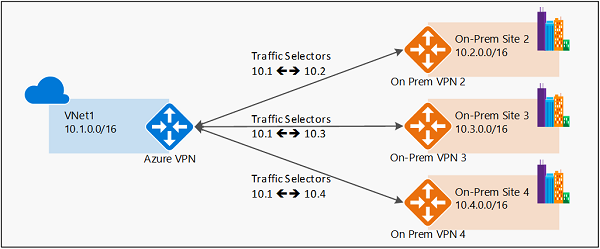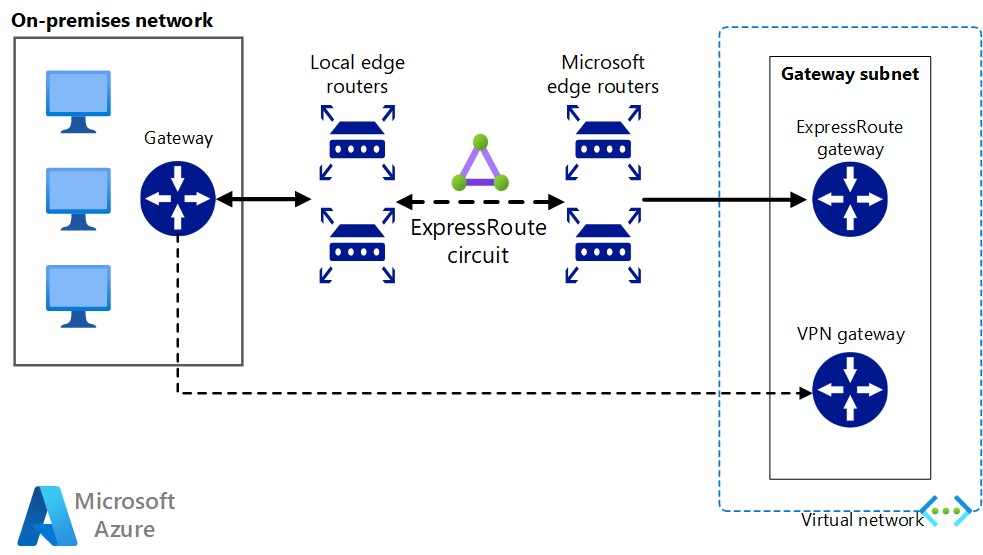Azure VPN gateways offer a number of advantages. You can connect to any region or one VPN to another, you can connect to multiple sites from the same VPN subscription, and you can also create your own VPN routers.
Microsoft Azure supports four different types of VPNs: Point-to-Site, Site-to-Site, Multisite, and ExpressRoute.
POINT-TO-SITE VPN
 You can connect securely to your virtual private network from a Windows-based computer using a point-to-site VPN without the use of any custom software. You can use the built-in VPN client in Windows by downloading VPN policies from Azure into your device. With this configuration, connecting to the VPN and using Azure is simple and secure. You can securely connect to Azure from any location because it makes use of the widely used Secure Sockets Tunneling Protocol (SSTP).
You can connect securely to your virtual private network from a Windows-based computer using a point-to-site VPN without the use of any custom software. You can use the built-in VPN client in Windows by downloading VPN policies from Azure into your device. With this configuration, connecting to the VPN and using Azure is simple and secure. You can securely connect to Azure from any location because it makes use of the widely used Secure Sockets Tunneling Protocol (SSTP).
These are 3 types of Point-to-Site VPNs that Azure supports:
- The Secure Socket Tunneling Protocol (SSTP), a Microsoft-exclusive SSL-based solution, can pass through most firewalls because it uses the outbound TCP port 443 SSL requires.
- OpenVPN is an SSL-based solution that can pass through them since most firewalls allow traffic from the outbound TCP port that 443 SSL uses,
- IKEv2 VPN is a standards-based IPsec VPN solution that operates on IP protocol number 50 and outbound UDP ports 500 and 4500. IKEv2 VPN may not be able to pass through proxies and firewalls because firewalls don’t always open these ports.
SITE-TO-SITE VPN
 You can establish a secure connection between your on-premises site and your virtual private network using a site-to-site VPN. Azure employs the generally accepted IPsec VPN protocol, which is compatible with most VPN hardware. This service enables you to safely link up to ten on-premises sites and virtual private networks. Only use this kind of VPN connectivity if your on-premises bandwidth is greater than 10 Mbps.
You can establish a secure connection between your on-premises site and your virtual private network using a site-to-site VPN. Azure employs the generally accepted IPsec VPN protocol, which is compatible with most VPN hardware. This service enables you to safely link up to ten on-premises sites and virtual private networks. Only use this kind of VPN connectivity if your on-premises bandwidth is greater than 10 Mbps.
MULTI-SITE VPN
 This kind of Site-to-Site VPN configuration enables you to connect more than one on-premises site to a virtual private network. The prerequisites are identical to those for a site-to-site VPN.
This kind of Site-to-Site VPN configuration enables you to connect more than one on-premises site to a virtual private network. The prerequisites are identical to those for a site-to-site VPN.
EXPRESSROUTE
 In essence, the ExpressRoute is a direct connection from your WAN to Azure, as opposed to a VPN connection using the open Internet. Compared to regular internet connections, this method provides greater security, reliability, and speed.
In essence, the ExpressRoute is a direct connection from your WAN to Azure, as opposed to a VPN connection using the open Internet. Compared to regular internet connections, this method provides greater security, reliability, and speed.
The Azure VPN Gateway Manager lets you manage your VPN gateways and VPNs. You can create and manage VPN gateways, add VPNs to gateways, configure VPNs on gateways, and manage VPN traffic.
Azure supports three types of VPNs: Point-to-Site (P2S), Site-to-Site (S2S), and VNet-to-VNet. P2S VPNs are used to connect an individual client computer to a VNet. S2S VPNs are used to connect an on-premises network to a VNet. VNet-to-VNet is used to connect two VNets together.
The Azure VPN Gateway Manager is free to use. You can download it from the Azure portal.
In conclusion, Azure supports many VPN types, including traditional VPNs, site-to-site VPNs, and ExpressRoute. VPN gateways let you connect to VPNs from anywhere in the world. The Azure VPN Gateway Manager lets you manage your VPN gateways and VPNs. You can also use the Azure VPN Gateway Manager to create reports showing your VPNs’ status and gateways. The Azure VPN Gateway Manager is free to use.